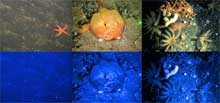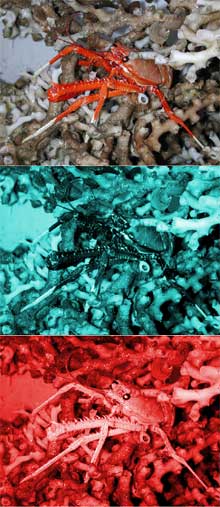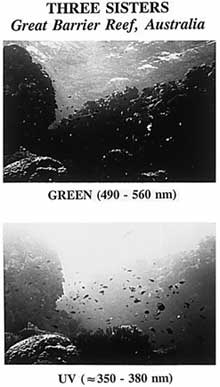
Fig 1: The top three panels show typical photographic views of deep-sea species. The lower panels show views that more closely approximate the real view under natural light. Note that animals that appear quite conspicuous under the submersible floodlights, such as the starfish and the fish, are fairly cryptic under ambient illumination. Note also that certain animals, such as the small white starfish in the rightmost panels, are still quite visible under natural illumination. The blue color in the lower panels is merely added for effect, given that most vision by deep-sea species is monochromatic. Click image for larger view and credits.
Underwater Imaging
Sönke Johnsen, PhD
Assistant Professor
Duke University
The world does not look the same to everyone. If we do not take this into account, we cannot really understand the lives of other animals. One of our goals during this mission is to see the ocean world as its inhabitants do, concentrating on two situations far from our own experience: 1) vision in the deep sea and 2) UV vision.
As Figures 1 and 2 show, the visibility of an animal depends a great deal on the illumination. Deep sea animals often appear quite conspicuous when photographed by full-spectrum cameras under full-spectrum illumination. In reality however, they are viewed under nearly monochromatic blue light by animals without color vision.

Fig 2: This deep-sea galatheid crab is highly visible under the full-spectrum submersible lights. At blue-green wavelengths, however, it is well camouflaged. At red wavelengths it is again quite conspicuous, because the disruptive coloration on the legs is no longer effective. Click image for larger view and credits.
These images (made by using only the blue channel of the digital imaging system) show that under these conditions the world looks quite different. Some species become quite well-hidden, others remain very obvious. Therefore, if we are to understand vision and coloration in the deep sea, we must view this world through the eyes of its inhabitants. One of our goals on this mission is to do just this.
Unfortunately, the light at the depth of the coral reef is too dim for good photography. Also, the sub pilots do not like to drive around in the dark! Therefore, we will cover the still camera of the Johnson-Sea-Link submersible with filters that will mimic the response of the typical deep-sea visual system under the ambient light found at 300 m depth. We determined what sort of filter to use by first measuring or obtaining the following:
- the underwater spectrum at that depth (see below)
- the spectral sensitivity of typical deep-sea inhabitants, measured
by co-explorer Tammy Frank
- the color of the lights on the submersible
- the color sensitivity of the camera on the submersible
These four pieces of information together tell use what filter we need to put in front of the camera. With this filter in place, we are now seeing the world like a fish in the deep.
Shallow Light
While we may not think of the shallow world as holding any visual mysteries, it does hold at least one -- ultraviolet (UV) light. This light is invisible to us, but not to many of the animals out there. In fact it looks as though about half the fish that live either near the surface or in coral reef habitats are able to see UV light.

Fig 3: Simultaneous images of a coral reef at green and UV wavelengths. Note how the increased background light silhouettes the fish in the UV image. Click image for credits.
A common reason given for UV vision is that it may help animals find food. While seeing any new wavelength band helps, UV light is special in a few ways. First, opaque animals are more visible in the UV because the background water near the surface is quite bright at these wavelengths (Figure 3). Second, while many plankton are clear as glass at visible wavelengths, they are often quite visible in the UV due to increased light scattering and the presence of UV-protective pigments (i.e. suntan lotion). In fact, the presence of both UV light and predators with UV vision presents a real problem for transparent plankton – do I protect myself from the sun, or from animals that want to eat me? We will study this problem by filming transparent animals underwater using specialized UV cameras and by measuring the underwater UV levels using spectroradiometers.


























